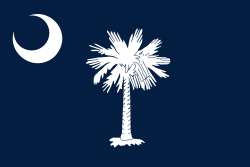Organization and history
When it was first formed, the 4th South Carolina Cavalry Regiment was commanded by Colonel B. Huger Rutledge and served in the 1st Military District of South Carolina, commanded by Brigadier General Roswell S. Ripley. The 1st Military District was in the Department of South Carolina, Georgia and Florida, under the command of General P. G. T. Beauregard. The 4th SC Cavalry served here from December 1862 until it was transferred to the Army of Northern Virginia in March 1864.
With 1,350 officers and men, the regiment was attached to the brigade known as Butler's Brigade under the command of Brigadier General Matthew Butler, which served under Major General Hampton's Division of cavalry, in the Cavalry Corps, Army of Northern Virginia.
It saw heavy action at the battles of Haw's Shop, Va., Matadequin Creek, Va., and Trevilian Station, Va. Between May 28, 1864, and June 12, 1864, the regiment suffered more than 280 killed, wounded or captured. [2]
In January 1865 the 4th SC Cavalry and all of Hampton's Division were detached from the Army of Northern Virginia and transferred south, by railroad, to the Department of Tennessee and Georgia, commanded by Lieutenant General William J. Hardee, and was under the Cavalry Command of Lieutenant General Hampton. Following the fall of Columbia, South Carolina, the unit, along with the entire Cavalry Command were transferred to the Army of Tennessee under General Joseph E. Johnston, where they fought final actions in the Campaign of the Carolinas through the spring of 1865, surrendering with the Army of the Tennessee with less than 200 men.
Of the seven cavalry regiments raised in South Carolina during the war, the 4th South Carolina lost more men than any other unit. More than 260 members of the 4th South Carolina were killed in action or died of wounds, disease or in federal prisoner of war camps. [3]
CORRECTION TO PRECEDING. Per the book Saddle Soldiers, the Correspondence of General William Stokes (Lt. Colonel of the 4th) by Lloyd Halliburton the 4th SC Cavalry did not surrender. The General's own words were "not desiring to go through the formality of surrendering the Regiment which I commanded, I ordered the camp struck at 8:30 P.M. and marched toward Asheboro, NC. ... At this place I disbanded the Regiment and sent them home." [4] On the morning of 27 April General Stokes awoke to find the teamsters had disappeared with the mule team of the headquarters wagon. He then ordered the wagon burned rather than allow it to fall into enemy hands. With that, most of the records, and history, of the 4th SC Cavalry disappeared.
This page is based on this
Wikipedia article Text is available under the
CC BY-SA 4.0 license; additional terms may apply.
Images, videos and audio are available under their respective licenses.


